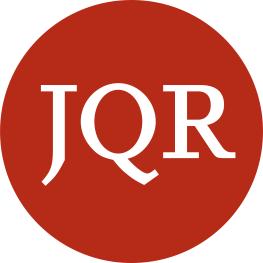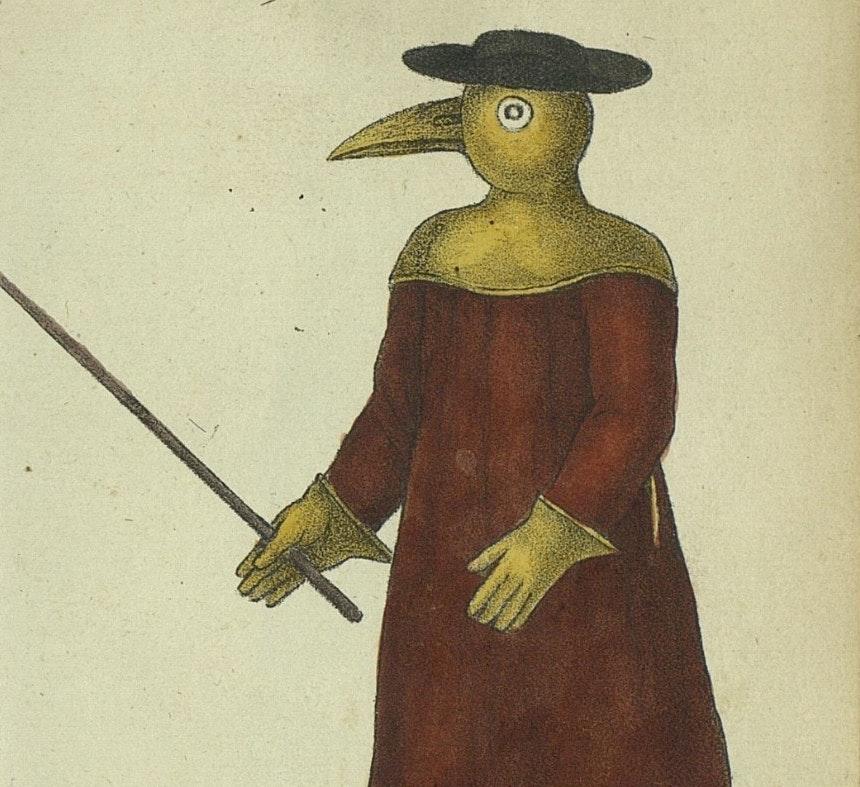Pandemic and Plague: Theological and Philosophical Reflections
A JQR blog forum

In response to the COVID-19 crisis, JQR organized a blog forum that brought together four historians to reflect on past outbreaks of disease in Jewish history and their echoes today.
One of the readers of that forum, Professor Zachary Braiterman, wondered whether it might make sense to bring together philosophers and theologians to share their reflections on the ongoing crisis through the lens of Jewish thought. This was a wise idea and the words below respond to the following questions: “What theological or philosophical reflections has the COVID crisis induced in you? To what Jewish sources have you turned or called upon in this moment?”
Now, on the eve of Passover, when Jews confront the powerful effects of plagues, including the ethical quandaries that arise in times of natural disaster, we present their responses. We will continue to draw on the rich resources of Jewish studies to remain engaged in our scholarly work and to make sense of where we are today.
The Editors of JQR
The Search for Meaning in the Era of COVID-19 Connectivity
Tamar Ross
Professor emerita in the Department of Jewish Thought at Bar-Ilan University
One of the remarkable features of our current pandemic is the role that technology and global connectivity are playing in both pernicious cause and remedial effect. This phenomenon conjures up a favorite passage of mine in the writings of Rabbi A. I. Kook, entitled “The Fundamental Changes in Contemporary Thought.” In this passage (which, given that it was written approximately 100 years ago, now appears uncannily prescient of current postmodern sensibilities), R. Kook points to parallel developments in three seemingly disparate disciplines: sociology, cosmology, and biology. Each of these disciplines, without any form of collusion between them, have shifted from a sense of the uniqueness and centrality of our particular cultural, astronomical or organic status, to one of interconnectivity and interdependence with a vast and fluid spectrum of being.
In keeping with this view, R. Kook believed that ideas do not emerge by chance; even our scientific models of reality are not developed in a void, but rather in response to our constantly evolving spiritual needs. Thus, the more integrated perception now replacing our previous view of an atomized universe of isolated beings and distinct borders is in actuality driven by an existential need to supplant our previous theistic theology with a more holistic approach. Instead of viewing God as a distinct and detached being up there in heaven, functioning as an all-powerful puppeteer maneuvering the strings of our destiny, we are now groping toward a more expansive understanding according to which we function in continuity with the “upper worlds” of an infinite divine reality, as well as with the more confined “lower worlds” of animal, plant and mineral life. Among other implications, I believe that this more inclusive perspective bears important repercussions on our understanding of theodicy in a corona-plagued environment. Instead of searching for God’s logic in inflicting such punishment upon us, we would do better investigating new techniques for preserving some sense of particularity and uniqueness while simultaneously recognizing the implications of living in a global village. This involves the need for developing a proper balance between universality and particularism that no longer distinguishes sharply between the natural and the supernatural, or between human endeavor and divine control.
How much agency does one have in a pandemic?
Martin Kavka
Professor of religion at Florida State University
How much agency does one have in a pandemic? Certainly, I can (and do) wash my hands thoroughly and obsessively. I can (and do) limit my contacts as much as I can. But what makes this particular moment so frightening to me is not being able to control my future. Contingency is everywhere.
Who, after all, was the last person to longingly touch that empty shelf in the grocery store where the rolls of toilet paper had once sat? (Why am I longingly touching shelves? How can I keep from touching my face for the minutes that I remain in the grocery store?)
How long is the incubation period for COVID-19? (It seems that there is a range. What is the top of that range, and why can I no longer remember all that I have touched in that period of time?)
As the number of positive tests in my county slowly increases, where can I hide? (Is hiding from others—others who are in need—even ethical?)
The story of Jewish theology is a story of attempting to master contingency. What it means for the people of Israel to enter into covenant with their God is to enter a logic in which there are rules that justify who will flourish and who will not. Various bits of Jewish vocabulary—“on account of our sins,” “afflictions of love,” “birthpangs of the Messiah,” and more—are ways to keep that logic working.
Theology has been on a respirator, thanks to this human labor. But contingency remains. Still, to read theology as a story of tragedy is to make the wrong inference from this story. Just imagine what humans could do for one another if they realized that they have long had the mighty power to make God breathe.
The public health
Randi Rashkover
Associate professor of religious studies at George Mason University
In the past two weeks, having read a number of religious responses to the current crisis, I have concluded that the litmus test for evaluating the worth of these responses is whether or not they directly contribute to the work of resolving the public health crisis. Ultimately, this may look like a pragmatic willingness on the part of religious thinkers to get out of the way and allow scientists to do what needs to be done. Alternatively, it may mean a deployment of the resources of religious reasoning to help adjudicate practically urgent questions concerning the ethical treatment of patients. If in other words, among my first impulses when reflecting upon the situation was to open up Joseph B. Soloveitchik’s Lonely Man of Faith in light of his sober appreciation for the fact that there are public problems whose range of effects inevitably shred the boundaries between communities, I also immediately recognized that Soloveitchik’s concern for the existential loneliness of Adam II does not speak to our current situation. Now is not the time for theology or for a retreat into our covenantal communities, but for a recognition of the overwhelmingly public character of this problem and the need for religious traditions to accommodate to its urgent demands.
Empty cities and empty streets
Aryeh Cohen
Professor of rabbinic literature at the Ziegler School of Rabbinic Studies, American Jewish University
Empty cities and empty streets. These are images of devastation. “Alas! Lonely sits the city once great with people,” laments the author of Lamentations, reflecting on Jerusalem after the first exile. Akiba centuries later, was also struck by the destroyed and profaned Jerusalem but he reacted differently.
When Akiba and his friends—Rabban Gamliel, Rabbi Elazar ben Azaryah, and Rabbi Yehoshuah—went up to the Temple Mount they saw a fox wandering out of the holy of holies. The fox walking on the Temple Mount was itself a sign of the desolation of Jerusalem (Lamentations 5:18), adding to the general destruction. Akiba, however, laughed while his friends cried. Akiba explained his laughter by saying that since the destruction fulfills Micah’s prophecy that “Zion shall be a plowed field,” it is now assured that Zechariah’s prophecy will also be fulfilled that “There shall yet be old men and women in the squares of Jerusalem […] and the squares of the city shall be crowded with boys and girls.” Again emptiness is the sign of destruction and crowded streets the sign of redemption.
Akiba knew of the joy of redemption in the crowded streets, but the Bavli’s Akiba knew that the squares of Jerusalem were also places of resistance. It was in the rabim, in the public square, that Akiba faced off against the empire. When the evil empire decreed that Jews should not study Torah, it is no accident that Akiba gathered great crowds in the public square to teach them Torah.
This was a sacred act, perhaps reflected in the opinion in the Mishnah that the town square is sacred because it is the place that people gather to pray and ask for mercy at times of distress. The streets and squares are the places of gatherings for justice.
This is where my mind goes in these days of enforced isolation. The streets of this city are desolate—not only bereft of the sounds of jubilation, but of the sacred sounds of justice demanded.
100 blessings
Laura Levitt
Professor of religion, Jewish studies, and gender studies at Temple University
The sense for the “miracles which are daily with us,”
the sense for the “continual marvels,” is the source of prayer.
(Abraham Joshua Heschel, God in Search of Man, 49)
In the Germantown section of Philadelphia where I live, it is common for people to say to one another, “Have a blessed day.” And, long before the outbreak of this pandemic, I was already wishing people a blessed day. These days in the very tiny space of the apartment where I am spending most of my time, I only see a few other human beings (mostly when I’m out walking my dog). But I have been thinking about blessings and making the everyday holy. To bless or be blessed is an affirmation, a statement of appreciation, and a humbling reminder that we are not in control. Lately, it is often the very smallest of things that I read as blessings. My father, who is 93, began drawing again with shaky hands. Via Zoom, we get to see each other most days despite the fact that he is locked down in his assisted living community. A friend posted a dream about my mother, she flickers back to life on Facebook. Another friend posts an audio clip of her five-year-old’s podcast about the virus, a still small voice comes to me while I am home alone with my dog. Blessings. Alongside my daily deep knee bends and one hundred jumping jacks, I think I need to start counting them.
Eliezer Berkovits and St. Camus
Zachary Braiterman
Professor of religion at Syracuse University
Who else made grim stupid jokes about The Plague (1947) at the first reported outbreaks of COVID-19, watching cities of millions under quarantine? And what does Camus have to do with Jewish thought and philosophy? A lot, actually. His appearance in Faith after the Holocaust (1973) by Eliezer Berkovits shows theology turning between the holy belief and holy disbelief of victims and survivors.
Radical Christian Death of God theology and existentialism make their due appearance in this timepiece from the 1960s. Camus’s first show in Faith after the Holocaust is brief and negative. Berkovits scolds those who hold that the world is meaningless apart from projections of human freedom and responsibility. But against Christianity, he turns to the radical theologians and Camus, to affirm nonetheless free human creativity and responsibility (pp. 52–55).
Camus reappears a second time. Because of insoluble problems posed by moral relativism after the Holocaust, rejected again is the notion that existence is absurd. But can one be a saint without God? The train of thought turns to the epiphany in The Plague when the two humanist heroes Tarrou and Dr. Rieux leave the city together to swim out into the bay. For Berkovits, the bay represents a “sphere of reality” outside human absurdity of the plague city, whereas the swim is the freedom there that institutes human solidarity. “Camus never solved the problem of how one could be a saint without God, yet he—and many others like him—were such saints, struggling ‘against this universe in which children suffer and die’” (pp. 75–76).
For secular saints and post-Holocaust theologians, “the problem of the good is no less serious a problem than the problem of evil” (p. 76).



